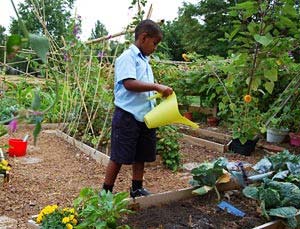What do Plants Need to Grow?
Water carries nutrients from the soil to all parts of the plant and carries food from the leaves back to the roots. Water is also needed to create the pressure that holds up a plant. Without water, the plant will wilt and eventually die.
Air consists of many things, including nitrogen, carbon dioxide, and oxygen. Plants must have carbon dioxide, light, and water in order to make their own food of sugars and starches. This process is called photosynthesis. Plants must also have oxygen in order to convert the sugars and starches to energy required to grow. The photosynthetic process provides more than enough oxygen for plants. Extra oxygen is released into the atmosphere and used by humans and other living organisms. A substance called chlorophyll, the chemical responsible for making plants green, is needed to convert the ingredients (water, nutrients, carbon dioxide) to plant foods. Plants need light energy so that chlorophyll is available to the plants.
Seeds also need air (carbon dioxide and oxygen) to grow. When a seed is completely submerged in water, gaseous oxygen needed to metabolize sugars and starches is not available. Therefore, the seed dies.









